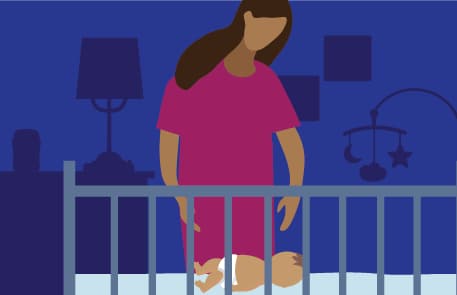Helping Babies Sleep Safely

Expecting or caring for a baby? Take these steps to help baby sleep safely and reduce the risk of sleep-related infant deaths, including sudden infant death syndrome (SIDS).
There are about 3,500 sleep-related deaths among US babies each year. CDC supports the updated 2016 recommendations issued by the American Academy of Pediatrics (AAP) to reduce the risk of all sleep-related infant deaths, including SIDS. See How to Keep Your Sleeping Baby Safe: AAP Policy Explained to learn more about these and other actions.
Parents and caregivers can help create a safe sleep area for babies by taking the following steps:
- Place your baby on his or her back for all sleep times—naps and at night. Even if a baby spits up during sleep, babies’ anatomy and gag reflex help prevent them from choking while sleeping on their backs. Babies who sleep on their backs are much less likely to die of SIDS than babies who sleep on their sides or stomachs.
- Use a firm, flat sleep surface, such as a mattress in a safety-approved crib covered only by a fitted sheet. Some parents and caretakers might feel they should place their baby on a soft surface to help the be more comfortable while sleeping. However, soft surfaces can increase the risk of sleep-related death. A firm sleep surface helps reduce the risk of SIDS and suffocation.
- Keep your baby’s sleep area (for example, a crib or bassinet) in the same room where you sleep until your baby is at least 6 months old, or ideally, until your baby is one year old. Accidental suffocation or strangulation can happen when a baby is sleeping in an adult bed or other unsafe sleep surfaces. Sharing a room with your baby is much safer than bed sharing and may decrease the risk of SIDS by as much as 50%. Also, placing the crib close to your bed so that the baby is within view and reach can also help make it easier to feed, comfort, and monitor your baby.
- Keep soft bedding such as blankets, pillows, bumper pads, and soft toys out of your baby’s sleep area. Additionally, do not cover your baby’s head or allow your baby to get too hot. Some parents may feel they should add sheets or blankets to their baby’s crib to help keep their baby warm and comfortable while sleeping. However, sheets, comforters, and blankets can increase the risk of suffocation or overheat your baby. If you’re worried about your baby getting cold during sleep, you can dress them in sleep clothing, like a wearable blanket. In a recent Pediatrics report, CDC scientists and colleagues found that infant suffocation deaths during sleep were most frequently due to soft bedding, such as blankets and pillows.
- View a safe sleep environment at What does a safe sleep environment look like? from Safe to Sleep.®
CDC Activities to Address Sleep-Related Infant Deaths
CDC’s Division of Reproductive Health (DRH) supports the monitoring of sleep-related infant deaths in 22 states and/or jurisdictions through its Sudden Unexpected Infant Death (SUID) and Sudden Death in the Young (SDY) Case Registries. Participating states and jurisdictions use data about trends and risk factors to develop strategies to reduce future deaths. Learn more about CDC resources, publications, and activities to address sleep-related infant deaths.
More Information






















.png)











No hay comentarios:
Publicar un comentario